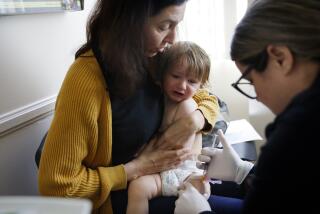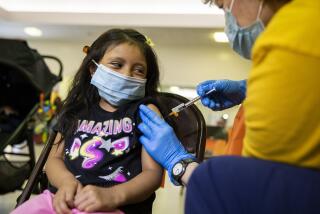Health Chief Aims to Boost Immunization Records
Diseases such as whooping cough and diphtheria, which were often deadly for past generations of children, are uncommon now, thanks to vaccines to prevent them. In fact, health-care professionals say, many young parents today do not regard them as a threat at all.
They couldn’t be more wrong, experts say.
“These diseases are still around, these diseases still kill kids, and they can still be prevented by giving immunizations,” said Dr. Hugh F. Stallworth, Orange County’s director of public health.
Only 60% of the county’s 2-year-olds, though, are fully immunized against polio, hepatitis, diphtheria, tetanus, measles, mumps, rubella and whooping cough, according to estimates by the California Department of Health Services. The estimate for urban Los Angeles is about the same.
By age 5, more than 97% of children are properly immunized, officials say, because that is a requirement for starting school. But younger children may be more vulnerable to the diseases and are less likely to have been vaccinated.
Given those statistics, Stallworth has set out to strengthen the first line of defense against illness by proposing a comprehensive immunization registry that would track vaccination records and would be updated every time a child visited a doctor, public or private.
By checking the database, health-care providers would know if the child is up to date on vaccinations. Those who were not on schedule could be immunized on the spot or referred to a free clinic.
With help from the database, if a boy or girl is in the emergency room with a fracture, “as they are setting the right arm, they can immunize the left one,” Stallworth said.
*
Such a registry is already being used at county-run clinics and includes data on about 150,000 children.
“We found that it worked quite well for public health,” Stallworth said. The goal now, he said, is to “take the existing system and make it countywide” by 1998.
The tracking system is necessary, officials say, because parents and health-care providers often keep only partial records--or none at all. About 25 counties in California, including Los Angeles, Ventura, San Diego, Kern and Santa Barbara, are working on similar database projects.
“It’s still in the feeling-out phase,” said Dr. Loring Dales, a state medical officer. “It’s just getting to be operational, but with the private sector, it’s still on a small scale.”
Dales said reminding parents and health-care workers to immunize children against less-common illnesses is essential “because we are so removed from vaccine-preventable disease, we feel a little cavalier. It doesn’t hit high on the priority list.”
To merge Orange County’s public registry with tracking by the private sector, an estimated $750,000 worth of new equipment is required.
In June, health-care company Kaiser Permanente Orange County gave the project a $25,000 shot in the arm. Money from other private and public sources is now being sought.
When Mary Ann Bycott, a Kaiser administrator, presented the check to the Orange County Board of Supervisors, she said her company is willing to work with the county to get the project online. CalOptima, a county health system that deals with Medi-Cal patients, also has pledged support.
Tracking the actual rate of immunization is not easy. By examining immunization records, the state estimates that 60% of Orange County children are fully immunized at 24 months. Figures from the Centers for Disease Control and Prevention in Atlanta put the rate for all of Southern California (there’s no breakdown for Orange County) at closer to 70% at 35 months. The latter figure was determined by telephone surveys and other methods.
*
Whether at 60% or 70%, the rate is too low, said Barbara Reynolds, a CDC spokeswoman.
“The reason we want high levels of vaccinations among children is to prevent disease,” she said. “To prevent disease outbreak, that coverage level has to be at 90% or better.”
Some parents might not know that their children should be immunized, and others might simply forget to keep up with the schedule. Still others might not be able to afford regular health care, but they have opportunities to protect their children by taking them to free vaccination clinics across the county, experts said.
Educating parents is vital, Stallworth said. “What we’re recommending when we talk to parents is, ‘You have to ask. Don’t wait for the provider to ask.’ ”
(BEGIN TEXT OF INFOBOX / INFOGRAPHIC)
Shot in the Arm
Vaccines to prevent hepatitis, influenza and polio are included in the childhood round of preventive care given by doctors. Ages at which children should have those immunizations and the common term for each vaccine:
*--*
TYPE OF VACCINE Diphtheria, Measles, Hepatitis Tetanus, Mumps, Age B Pertussis Meningitis Polio Rubella Birth B1 1 month B2 2 months DTap or DTP Hib Polio 4 months DTap or DTP Hib Polio 6 months B3 DTap or DTP Hib 12 months Hib 4-6 years DTap or DTP Polio MMR 11-12 years B* Td 14-16 years Td
TYPE OF VACCINE Chicken Age pox Birth 1 month 2 months 4 months 6 months 12 months Var 4-6 years Var 11-12 years Var 14-16 years
*--*
* At age 11-12, vaccine should be administered to children not previously vaccinated.
WHERE TO GO:
Free immunization clinics are held in several cities around Orange County. To receive treatment, bring all immunization records. Parents or guardian must also be present. Four of the county’s largest free clinics:
* Buena Park
Address: 7342 Orangethorpe Ave.
When: Tuesdays, 8 a.m.-4:30 p.m.; Thursdays, 8 a.m.-7:30 p.m.
* Costa Mesa
Address: 2845 Mesa Verde Drive East
When: Wednesdays, 11 a.m.-7:30 p.m.
*San Juan Capistrano
Address: 27512 Calle Arroyo
When: Thursdays, 11 a.m.-7:30 p.m.
* Santa Ana
Address: 1725 W. 17th St.
When: Mondays-Fridays, 8 a.m.-4:30 p.m.; Tuesdays, 4:30-7:30 p.m.
More Information
For information about other free immunization clinics in your city, call the Health Referral Hotline, (800) 564-8448.
Source: Orange County Health Care Agency, Researched by JOHN CANALIS, For The Times
More to Read
Sign up for Essential California
The most important California stories and recommendations in your inbox every morning.
You may occasionally receive promotional content from the Los Angeles Times.









